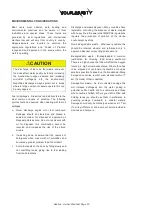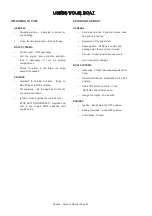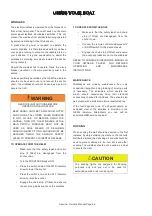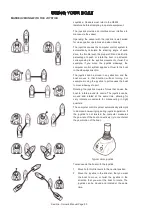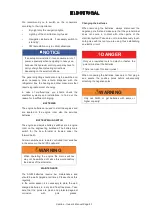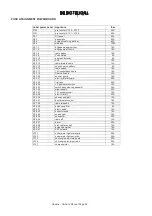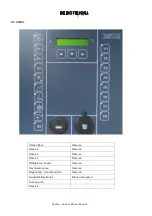
86,1*<285%2$7
6HDOLQH2ZQHUV0DQXDO3DJH
BOARDING
ವ
DO NOT overload the boat. Refer to
builder's plate. Load to less than capacity in
adverse conditions.
ವ
Board one person at a time and give
assistance as needed. Transfer gear and
equipment by handing it from a person on
the dock to a person on board. You can lose
your balance and be injured if you attempt
to board while carrying equipment or gear.
ವ
Distribute the weight of equipment and
passengers as evenly as possible to keep
the boat balanced.
ವ
Stow gear and equipment so that it is
accessible, but everything is to be stored in
places so as to prevent it from flying about if
the boat encounters rough water or weather.
LIFEJACKETS
Operator must instruct all passengers on location
and use of life jackets.
ವ
Children under sixteen (16) years of age
and all non-swimmers, adults as well as
children, must wear properly sized life
jackets at all times when aboard.
ವ
ALL passengers should wear life jackets. By
the time someone falls overboard, it can be
too late for them to put on a life jacket and
fasten it properly. This is especially true in
colder waters, below 15°C, where survival
time, before hypothermia sets in, is
measured in minutes.
If there are passengers not wearing life jackets, then:
ವ
Life jackets must be readily accessible.
"Readily accessible" means out of the
storage bag and unbuckled.
ವ
All throwable flotation devices (cushions,
rings, etc) must be right at hand.
PASSENGER INSTRUCTION & LOCATION
Everyone on board must be told about the boat's
behaviour from starting to getting up on plane.
Before
the
operator
does
any
high-speed
manoeuvres or rapidly accelerates or decelerates the
boat, passengers must be warned to sit and hold on
and must heed the warning.
The operator may have to make rapid changes in
speed and/or direction to avoid a problem, with little
or no time for alerting passengers. It is critical that all
passengers be seated in the designated seating
areas and holding on to prevent falling overboard or
getting knocked about in the boat at all times when
the boat is underway.
When persons are on the working deck area, for
anchoring, mooring or in emergencies, they must be
holding on and be positioned so as to prevent falling.
In bad weather and/or rough water, if it is essential to
be on deck, persons should be closely tied to cleats,
railing stanchions or other securely fastened boat
hardware.
WARNING
Boat motion can be erratic. You can fall overboard
or be injured by hitting something in or on the
boat. All persons must be in cockpit area or cabin
and be prepared for sudden boat movement. Use
front or bow deck area only during anchoring,
mooring or emergencies.
Summary of Contents for S450
Page 1: ... ...
Page 2: ... ...
Page 6: ... 6HDOLQH 2ZQHU V 0DQXDO 3DJH ...
Page 55: ... 75 6HDOLQH 2ZQHU V 0DQXDO 3DJH AC PANEL 10 10 16 10 16 16 16 16 16 10 16 10 ...
Page 81: ... 7 1 6HDOLQH 2ZQHU V 0DQXDO 3DJH ...
Page 82: ... 6HDOLQH 2ZQHU V 0DQXDO 3DJH DATA SHEETS DIAGRAMS PRINCIPAL DIMENSIONS ...
Page 84: ... 6HDOLQH 2ZQHU V 0DQXDO 3DJH DECK PLAN ...
Page 86: ... 6HDOLQH 2ZQHU V 0DQXDO 3DJH SYSTEM CONTROL POINTS ...
Page 88: ... 6HDOLQH 2ZQHU V 0DQXDO 3DJH EQUIPMENT LOCATION ACCOMMODATION SPACE ...
Page 90: ... 6HDOLQH 2ZQHU V 0DQXDO 3DJH GAS SYSTEM LAYOUT ...
Page 92: ... 6HDOLQH 2ZQHU V 0DQXDO 3DJH FIRE PROTECTION SYSTEM 3 4 1 5 6 8 1 2 7 8 8 1 ...
Page 94: ... 6HDOLQH 2ZQHU V 0DQXDO 3DJH BLACK WATER SYSTEM ...




